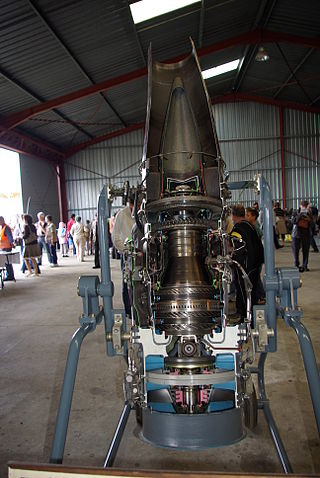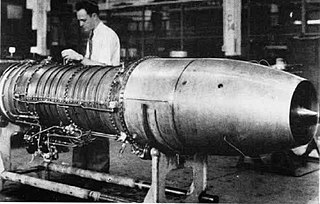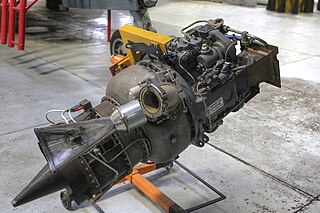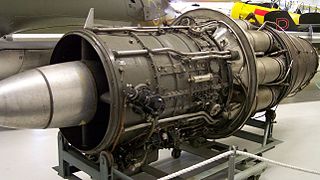Related Research Articles

The Armstrong Siddeley ASA.1 Adder was an early British turbojet engine developed by the Armstrong Siddeley company and first run in November 1948.

The Turbomeca Marboré is a small turbojet engine that was produced by Turbomeca from the 1950s into the 1970s. The most popular uses of this engine were in the Fouga CM.170 Magister and the Morane-Saulnier MS.760 Paris. It was also licensed for production in the United States as the Teledyne CAE J69. In Spain the Turbomeca model Marboré II was manufactured by ENMASA under license with the name Marboré M21.

The Garrett TFE731 is a family of geared turbofan engines commonly used on business jet aircraft. Garrett AiResearch originally designed and built the engine, which due to mergers was later produced by AlliedSignal and now Honeywell Aerospace.

The CFE CFE738 is a small turbofan engine aimed at the business/commuter jet market manufactured by the CFE Company, and is used on the Dassault Falcon 2000.

The Turbomeca Astazou is a highly successful series of turboprop and turboshaft engines, first run in 1957. The original version weighed 110 kg (243 lb) and developed 240 kW (320 shp) at 40,000 rpm. It was admitted for aviation service on May 29, 1961, after a 150-hour test run. The main developing engineer was G. Sporer. It was named after two summits of the Pyrenees.

The Turbomeca Palas is a diminutive centrifugal flow turbojet engine used to power light aircraft. An enlargement of the Turbomeca Piméné, the Palas was designed in 1950 by the French manufacturer Société Turbomeca, and was also produced under licence by Blackburn and General Aircraft in the United Kingdom and Teledyne Continental Motors in the United States as the Continental Model 320.
The Fouga CM.88 Gemeaux was a 1950s French engine test-bed aircraft produced by Fouga. An unusual aircraft, it was two aircraft joined by a common wing.

The SNECMA Turbomeca Larzac is a military turbofan manufactured by GRTS, a consortium between the two French companies, SNECMA and Turbomeca. Its main application was on the Dassault/Dornier Alpha Jet.

The Turbomeca Aubisque was a small turbofan engine designed and produced by Turbomeca in the 1960s. Its only application was the Saab 105 military trainer aircraft as the RM9. The engine is named after the Col d'Aubisque in the Pyrenees mountains, in line with company tradition.

The Westinghouse J30, initially known as the Westinghouse 19XB, was a turbojet engine developed by Westinghouse Electric Corporation. It was the first American-designed turbojet to run, and only the second axial-flow turbojet to run outside Germany.

The Fairchild J44 was a small turbojet developed in the 1940s by the Fairchild Engine Division.

The Continental CAE T51 was a small turboshaft engine produced by Continental Aviation and Engineering (CAE) under license from Turbomeca. A development of the Artouste, it was followed by three additional turboshaft engines, the T72, the T65, and the T67. However, none of these engines, including the T51, entered full production. CAE abandoned turboshaft development in 1967 after the XT67 lost to the Pratt & Whitney Canada PT6T (T400) to power the Bell UH-1N Twin Huey.
The Turbomeca Astafan is a single-spool, variable-pitch turbofan engine developed from the Turbomeca Astazou. Despite successful flight-testing, an efficient, quiet and clean design and some commercial interest, the Astafan never entered series production. The engines were only flown on the Fouga 90 prototype and Turbomeca's two test aircraft.

The Turbomeca Palouste is a French gas turbine engine, first run in 1952. Designed purely as a compressed air generator, the Palouste was mainly used as a ground-based aircraft engine starter unit. Other uses included rotor tip propulsion for helicopters.

The Napier Oryx was a British gas-turbine engine designed and built by Napier in the early 1950s for the Percival P.74 tip jet-powered helicopter project. The P.74 was unsuccessful and it and the Oryx were cancelled.

The Turbomeca Gabizo was a small turbojet engine produced by Turbomeca from the 1950s. The components were designed to take the stresses of high-speed fighter aircraft with some variants featuring afterburner.

The STAL Dovern was a Swedish turbojet design of the early 1950s, named after a lake in Finspång municipality in Östergötland, Sweden. Intended to power the Saab 35 Draken, this aircraft was powered by the Rolls-Royce Avon instead. The Dovern did not enter production.
The Turbomeca Piméné was a small French turbojet engine produced by Turbomeca in the early 1950s.
The Turbomeca Orédon was a small French turbo-shaft / Auxiliary Power Unit (APU) engine produced by Turbomeca in the late 1940s.
The Daimler-Benz DB 007 was an early German jet engine design stemming from design work carried out by Karl Leist from 1939. This was a complex design featuring contra-rotating stages and a bypass fan, making it one of the earliest turbofan designs to be produced. The end result of the design work was built as the DB 007 and began testing on a test-bed on 27 May 1943. Due to the expected low performance, complexity and the good results achieved by much simpler designs, work was halted on the DB 007 in May 1944 by order of the RLM.
References
- Notes
- Bibliography
- Gunston, Bill. World Encyclopedia of Aero Engines. Cambridge, England. Patrick Stephens Limited, 1989. ISBN 1-85260-163-9
- Wilkinson, Paul H. Aircraft engines of the World 1953. London, England. Sir Isaac Pitman & Sons Limited. 1953.